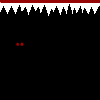Palamedes is a unique puzzle game like no other. You match up the dice and try to come up with the best combinations. (Poker anyone?)
You clear rows of blocks by making the best hands:
| hand | description | lines cleared |
|---|
| 1 pair | 2 of the same number in a row | 1 line |
| 2 pairs | 2 pairs of numbers | 2 lines |
| 3 pairs | 3 pairs of numbers (trifecta) | 3 lines |
| 3 of a kind | 3 of the same number in a row | 1 line |
| 4 of a kind | 4 of the same number in a row | 2 lines |
| 5 of a kind | 5 of the same number in a row | 3 lines |
| 6 of a kind | 6 of the same number (flush) | 4 lines |
| 3 number straight | 3 consecutive numbers in a row | 1 line |
| 4 number straight | 4 consecutive numbers in a row | 2 lines |
| 5 number straight | 5 consecutive numbers in a row | 3 lines |
| # of a kind straight | combination of the two | 3 lines |
| black jack | hand with numbers totaling 21 | 1 bonus line |
| straight flush | 6 consecutive numbers | 5 lines |
Differences on start-up: The screen with the HOT-B logo can be skipped in the Japanese version which discounts the extra frames in the US version.
I do the Tournament mode and be strategic as much as possible. The first opponent was a pushover, but it gets harder along the way.
There might be room for possible small improvements.
Samsara: Alright, bear with me here. Researching the game and weighing the pros and cons of the run has occupied the better part of my waking hours for the past two days, and I've come to the conclusion that this run just isn't publishable. But moreso than that, the game itself isn't publishable either as far as I'm concerned.
The issues with the run are simply that it doesn't seem like there was any testing done to get different/possibly better board layouts. Obviously, we can't expect every single possibility to be tested unless you have the patience of a lesser saint, but we expect at least some testing, rather than doing everything you get as fast as possible. A TAS isn't supposed to merely react to something with superhuman precision, it's supposed to change the world to its liking. It's clear that even single frame delays (whether at the title screen or delaying finishing off the enemy) can influence the board pattern of the next stage, so there should have been more effort put into finding better patterns.
But that's just general TASing advice, the main issue I have is with the game itself.
The board pattern does not change at all once it's set: Using the same "seed" as this submission, I matched the first stage in realtime. This ultimately means that TAS precision makes almost no difference over the majority of the game, with the only possible changes being luck manipulation, and even then I've only seen 1 or 2 dice change per line, so it's not even enough manipulation to count. The reason why it's so easy to match the run in RTA is because, frankly, well over half of the run is spent waiting for lines to come down. Without lines of your own, you can't send lines to the opponent, and you can't control the speed that the lines slowly, slowly, slowly, slowly, slowly, slowly come down. This, in my opinion, makes the game too trivial to be published. It's not as simple as, say, literally pressing nothing but right for 5 minutes and beating the game, but it's simple enough that a day after playing the game for the first time, I can match a TAS almost frame-for-frame even without the perfect reflexes or timing. Sure, I would get a different level layout for the next round, but I and anyone else would be able to easily get within frames of a TAS of that level as well.
Of course, I could be wrong about the game, and it could be publishable, but even then I would still be leaning toward rejection due to the lack of testing. While what's here is "optimized" as much as the game will allow, it doesn't exactly scream mastery of the game to just take the first result you get in every case and go on from there.
Rejecting.





